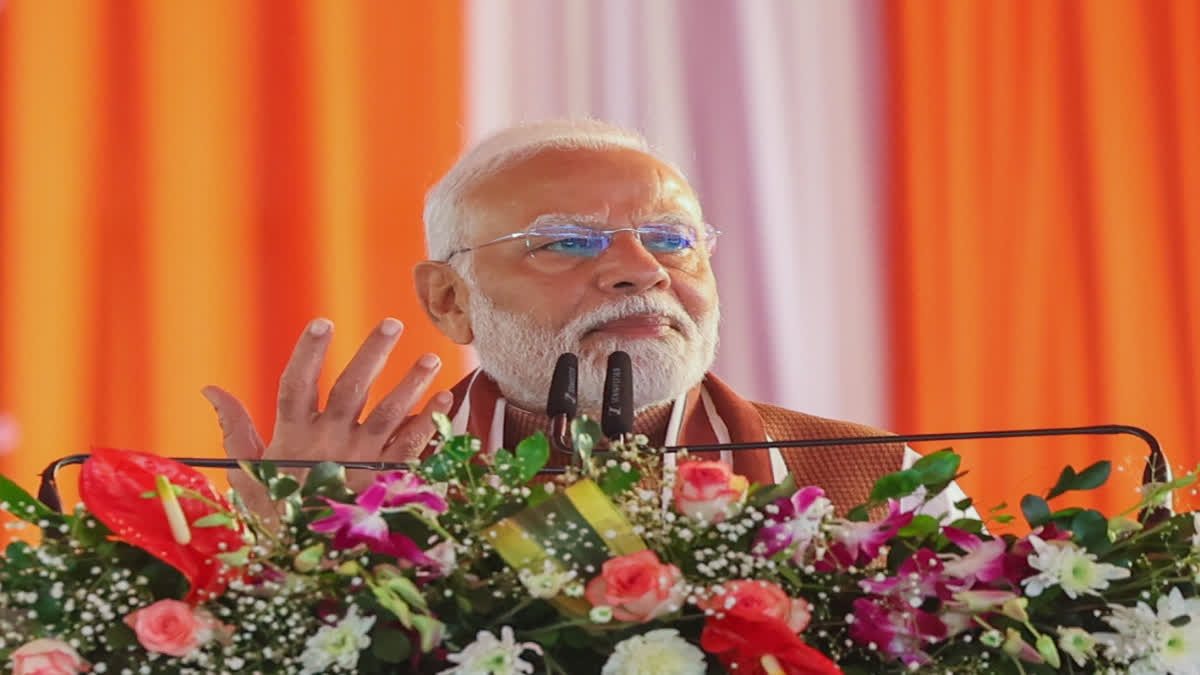New Delhi: On the third and final leg of his upcoming three-nation tour to Africa and South America, Prime Minister Narendra Modi will be in Guyana from November 19 to 21.
This will be the first prime ministerial visit from India to the South American country in more than half a century. It marks an uptick in bilateral exchanges between the two countries and New Delhi's growing footprint in the Caribbean in recent times.
Guyanese President Mohamed Irfaan Ali was the chief guest at Pravasi Bharatiya Divas, the Indian government's flagship event for the diaspora, in January last year. The next month, Vice President Bharrat Jagdeo visited India. Prime Minister Mark Phillips also visited India in February this year. External Affairs Minister S Jaishankar visited Guyana in April last year and met the entire leadership at that time.
The diaspora context
A major reason why Guyana has emerged as an important partner of India in the region is the presence of a significant number of Indian diaspora. Around 40 per cent of the country’s population is of Indian origin. Indians were first taken to Guyana as indentured labour in 1838. So, the Indian presence there is now more than 180 years old.
Ash Narain Roy, Director of the New Delhi-based Institute of Social Sciences (ISS), speaking to ETV Bharat, gave the perspective of Modi’s visit to Guyana in the context of the Indian diaspora.
"India and the Caribbean have always been very close due to the presence of a large Indian diaspora, especially in Guyana, Suriname and Trinidad & Tobago," Roy explained.
"Most of the India-origin people in these countries were taken by the British from the Bhojpuri-speaking regions of Uttar Pradesh and Bihar. Thanks to their hard work, despite all the adversities they faced, they could contribute to the rural agricultural sector, particularly in sugarcane plantations."
He said that when the British realised that there was a huge market for sugar across the world, they first brought in labourers from Africa. However, the African labourers lacked expertise in agriculture. That is when the British decided to take in Indians as indentured labour.
"The Indians had the knowledge and ability to not only contribute to the economy but also preserve their culture,” Roy said. "Both Hindus and Muslims were taken from India and they continue to celebrate their festivals like Diwali and Eid even today."
He said that India’s soft powers like culture, religion, art and music make these diaspora connections very strong. Many Indian-origin people in the Caribbean and Latin and South America come to India to trace their origins.
India's emphasis on cultural diplomacy includes strengthening connections through Indian cultural events, scholarships for Guyanese students, and collaborations in educational programmes. Guyana’s Indian community has a strong connection to Indian traditions, making cultural and educational programs particularly impactful.
During his visit, Prime Minister Modi will have delegation-level talks with President Irfaan Ali. He will also address the National Assembly of Guyana as well as the Indian diaspora.
"The Prime Minister’s visit to Guyana is in line with the current government’s policy of engaging with the Indian diaspora abroad and reaping dividends from this," Saurabh Mishra, Research Fellow at the Manohar Parrikar Institute of Defence Studies and Analyses, told ETV Bharat.
Mishra said that both India and Guyana are thriving democracies.
"Guyana has an active democracy and a strong civil society," he said. “Major concerns for Guyana are environmental issues and some social tensions regarding ethnicity.”
So, what are the environmental concerns and how can India and Guyana collaborate?
“Guyana has many areas that are below the sea level,” Mishra said. “There are possibilities of formulating common perspectives on global platforms with reference to rising sea levels.”
Energy security
Another reason why Guyana has emerged as an important partner for India in the region is the discovery of significant reserves of oil and gas.
"Guyana is, as you know, on the cusp of an economic and developmental transformation with a major discovery of oil and gas," Jaideep Mazumdar, Secretary (East) in the Ministry of External Affairs, said during a media briefing here Wednesday about the Prime Minister’s upcoming three-nation visit that will also take him to Nigeria and Brazil. “We hope to partner them in a number of fields, including in hydrocarbons.”
India and Guyana have agreed to cooperate in the hydrocarbon sector, including long-term crude purchases from the South American country and investment in its upstream sector. Since 2015, Guyana has emerged as a significant global player in the oil industry, with discoveries of crude oil reserves exceeding 11 billion barrels. This has positioned the small Caribbean nation as home to one of the largest oil reserves globally. Concurrently, New Delhi has actively pursued diversification in its oil supply sources, establishing agreements with countries such as Brazil and Colombia.
Indian Oil Corporation Ltd (IOCL) purchased one million barrels of Liza crude oil from the Government of Guyana’s share of oil. Earlier a consortium of HPCL-Mittal Energy had purchased 1 million barrels in March 2021.
Indian energy companies, particularly Oil and Natural Gas Corporation Videsh (ONGC Videsh) and Oil India Limited (OIL), have shown interest in participating in Guyana’s oil and gas sector. India aims to establish a foothold in Guyana’s energy market to help meet its domestic energy demands while reducing dependence on oil from West Asia.
“We are exploring possibilities for cooperation with the Guyanese government to develop oilfields discovered there recently,” Mishra said.
Developmental aid
India is also an important developmental aid partner of Guyana.
"We have had a long-standing developmental partnership with Guyana and this is in the fields of health, in connectivity, in renewable power, in water,” Mazumdar said during the briefing. "The GRSE (Garden Reach Shipbuilders and Engineers of India) built an ocean-going ferry which we supplied to Guyana last year and we also supplied two HAL-228 aircraft under a line of credit to Guyana this year. Solar lighting has been provided for about 30,000 households and we have so far had 800 ITEC (Indian Technical and Economic Cooperation) alumni from Guyana who have studied in India."
Bilateral trade
Total India-Guyana trade in 2021-22 amounted to $223.36 million with exports of $66.41 million and imports of $156.96 million, a tremendous increase from $46.97 million in 2020-21. During 2022-23, the trade dipped to $66.37 million, which, however, picked up in 2023-24 to $105.97 million with exports of $99.36 million and imports of $6.61 million.
Second India-CARICOM Summit
During the course of his visit to Guyana, Prime Minister Modi will also co-chair the Second India-CARICOM Summit.
"Prime Minister will also co-chair the second India-CARICOM Summit along with the Prime Minister of Grenada who is the current Chair of CARICOM, and there will be the leaders of all CARICOM countries present in Guyana for that occasion as well as the Secretary General of CARICOM,” Mazumdar said. “This is only the second Summit between India and CARICOM and the first in a CARICOM country. The only other Summit that was held was in 2019 on the margins of the United Nations General Assembly in New York and this is a significant Summit and we expect to have a very rich agenda of cooperation with CARICOM during this Summit.”
The Caribbean Community (CARICOM) is an intergovernmental organisation that is a political and economic union of 15 member states (14 nation-states and one dependency) and five associated members throughout the Americas, The Caribbean and the Atlantic Ocean. It has the primary objective to promote economic integration and cooperation among its members, ensure that the benefits of integration are equitably shared, and coordinate foreign policy.
"India has recently undertaken the policy of focusing more on the Caribbean and Latin American regions,” Mishra explained. “This highlights New Delhi’s evolving approach to engage with the neglected regions of the world or the Global South. This is an imperative in the contemporary world with dynamic geopolitics full of uncertainties.”
On his part, Roy pointed out that the CARICOM has brought the Caribbean and Latin America together. "The India-CARICOM Summit will be a boost to India’s trade and economic exchange and help in the regional integration process,” he said.



